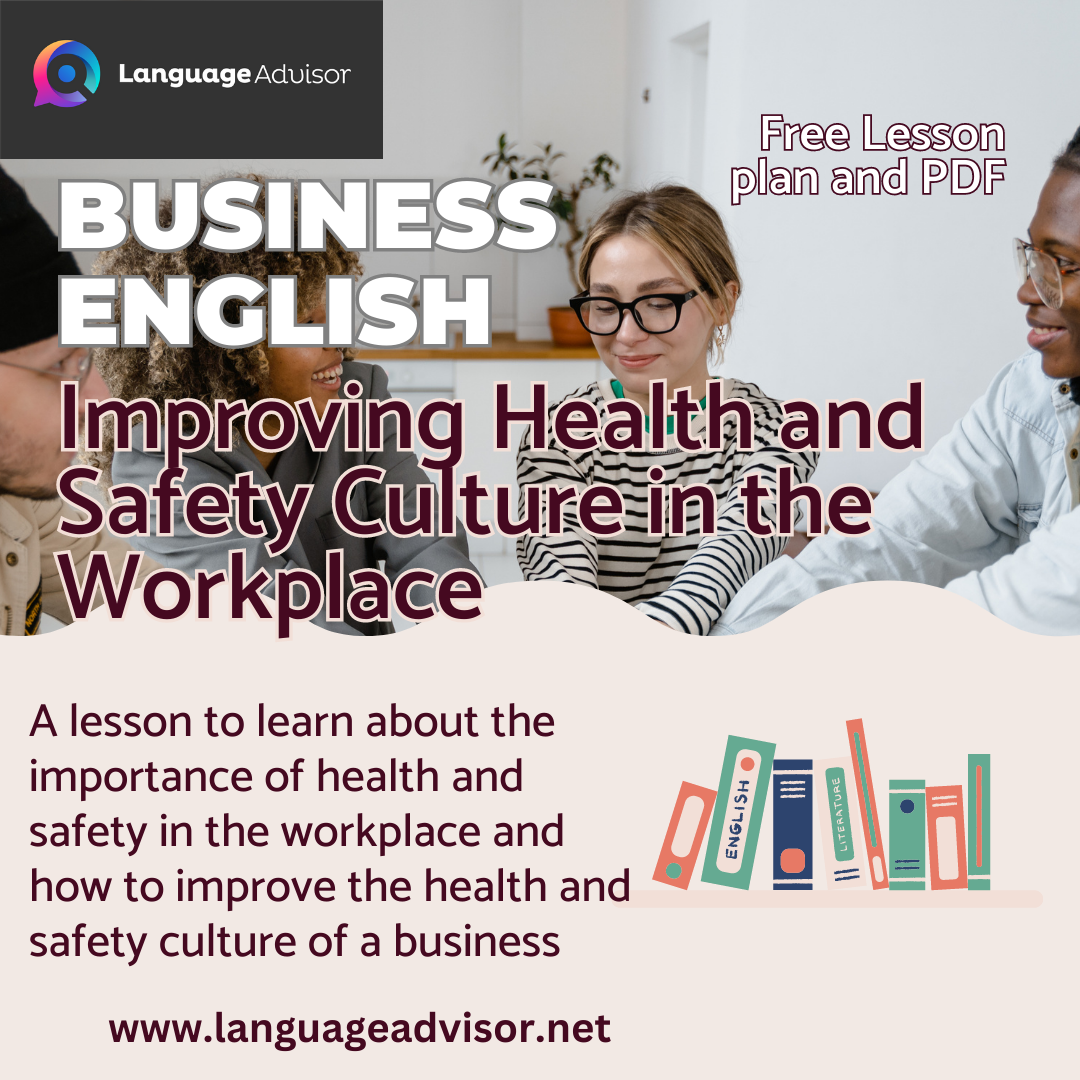Business English Lesson: Improving Health and Safety Culture in the Workplace. A lesson to learn about the importance of health and safety in the workplace and how to improve the health and safety culture of a business with free PDF.
Business English Lesson: Improving Health and Safety Culture in the Workplace

Business English Lesson: Improving Health and Safety Culture in the Workplace
Objective:
In this lesson, students will learn about the importance of health and safety in the workplace and how to improve the health and safety culture of a business. They will explore the concepts of hazards, risks, hazard management, reporting procedures, and the role of induction and refresher courses
This lesson is suitable for intermediate to advanced level students of Business English.
Warm-up:
Ask students to discuss in pairs or small groups why they think health and safety is important in the workplace. Have them share their ideas with the class and lead a brief discussion.
Vocabulary:
Introduce and explain the following vocabulary terms:
- Health and safety regulations
- Hazards
- Risks
- Hazard management
- Isolate
- Minimize
- Eliminate
- Reporting procedures
- Induction
- Refresher courses
- Repercussions
- Coercive
- Breaches
Reading Comprehension:
- Provide students with a copy of the article.
- Have them read the article individually.
- Discuss the main ideas and key points from the article as a class.
- Ask students to explain the difference between hazards and risks based on what they have read.
Discussion Questions:
- Why do you think health and safety regulations are sometimes seen as a hindrance to productivity?
- How can businesses ensure that employees understand the importance of health and safety regulations?
- Give examples of hazards that could be present in a workplace.
- How can hazards be dealt with? Explain the concepts of isolate, minimize, and eliminate.
- Why is it important to have clear reporting procedures for hazards?
- What role does induction and refresher courses play in improving health and safety culture?
- Why is it crucial for employees to be able to report hazards without fear of repercussions or disciplinary action?
- How can a strong health and safety culture benefit a business?
Case Study
Provide students with a case study of a workplace that faced a health and safety breach. Ask them to analyze the case study and identify what went wrong, what could have been done differently, and how the health and safety culture could have been improved to prevent the breach. Encourage students to discuss the importance of reporting procedures and the role of employees and managers in ensuring a safe working environment.
Role Play Activity:
Divide students into pairs or small groups. Assign each group a workplace scenario where a health and safety hazard is present. In their roles, students should discuss and role-play how they would identify, report, and deal with the hazard according to the principles discussed in the article. Encourage them to consider communication, reporting procedures, and potential solutions.
Writing Activity:
Have students write a short memo or safety guideline document for employees, emphasizing the importance of health and safety and providing instructions on how to identify, report, and manage hazards. Encourage them to use clear and concise language and include relevant examples.
Wrap-up:
Ask students to share their role-play experiences, case study analyses, or written memos with the class. Facilitate a discussion on the key takeaways from the lesson and the importance of fostering a strong health and safety culture in the workplace.
Extension Activity:
Students can research and present case studies of businesses that have successfully improved their health and safety culture. They can explore the strategies implemented, the challenges faced, and the outcomes achieved. Alternatively, they can conduct a mock safety inspection of their own workplace or a chosen business, identifying hazards and proposing solutions to improve health and safety.
Note: The teacher should adapt the lesson based on the proficiency level and needs of the students. Additional activities such as vocabulary exercises, grammar practice, or listening comprehension can be included as necessary.

Business English Lesson: Improving Health and Safety Culture in the Workplace – Here is the article:
Improving Health and Safety Culture in the Workplace
Health and Safety in the workplace is an integral part of any business. Ensuring that health and safety regulations are met can be a challenging process, even in industries where the risk of injury is minimal. In recent years, health and safety regulations have been vilified as an unnecessary hindrance to productivity, which is why it’s essential to explain in simple terms why health and safety regulations are in place.
Improving the health and safety culture of a workplace starts primarily with the employee, as they are the one primarily responsible for the safety of themselves and others around them. One of the main reasons that health and safety regulations are often overlooked is simply because the employee does not entirely understand why the regulations are in place to begin with. This is why it is crucial to ensure that all employees are acutely aware of not just what the regulations are, but why they are applied.
Some actions that may seem safe may present a hazard when repeated over long periods of time. This could be anything from typing on a keyboard, to sitting in a chair. Health and safety does not just apply to jobs such as construction, where the risk of immediate injury is ever-present. Educating your employees with facts, statistics and real-life examples of the results of poor health and safety management, help to ensure that employees take health and safety seriously, rather than treating it as just another formality.
Hazards and Risks
In order to foster a safe atmosphere, it is important to ensure that employees are aware of the differences between a hazard and a risk. This ensures that employees can recognise potential hazards and identify immediate risks, and in turn, report them through the proper procedure.
Simply put, a Hazard is anything that can cause harm (either in the long term or the short term), this could be electricity, noise, pollution, an obstruction, a tripping hazard, damaged or outdated tools, or something less obvious, like an uncooperative or intimidating employee, or stress.
A risk is the likelihood (low or high) of a hazard causing injury. Hazards need to be isolated, minimised or eliminated before they become risks.
Isolate, minimise and eliminate
This is a method of dealing with hazards in the proper manner. When a hazard is identified, it must be dealt with immediately. Ideally, all hazards should be eliminated, if this is not possible, they should be isolated, and if this cannot be done, they should be minimised.
For example, the presence of an exposed live wire presents a serious hazard with the risk of immediate and serious injury. Eliminating the hazard would involve removing the exposed wire entirely, isolating the hazard would involve sectioning off the area so that it is inaccessible and cutting off the power, minimising the hazard would mean ensuring the employees are all aware of the hazard, and are wearing the proper protective equipment. Obviously, when there is a risk of serious injury, the hazard should be eliminated entirely.
Reporting hazards
One of the biggest reasons that’s hazards are not dealt with properly is that the employees simply do not know how to report them properly. This is why it is essential to have a simple, clear line of communication and reporting procedure that employees are all aware of, and can use without fear of repercussions. If for example, an employee damages a piece of equipment, they may be reluctant to report it for fear of disciplinary action. This presents an enormous hazard for other employees using the equipment, as they may be unaware of the damage.
Induction and refresher courses
In order to foster a safe working atmosphere, it is essential to ensure that all employees are educated thoroughly on the importance of health and safety, and how to deal with and report hazards properly. This should not be done by simply handing out a contract for the employee to read and sign, they should be given proper training, along with refresher courses at regular intervals or whenever a new potential hazard emerges, and tested to ensure that all employees are fully aware of the importance of health and safety, how to identify hazards and report them.
The most important thing is to ensure that employees can report hazards without fear of repercussion. All too often, an overly coercive employee or manager may pressure an employee to work in unsafe conditions in order to get a job done quickly. It’s essential that employees do not feel like their job is at risk for reporting health and safety breaches.

Business English Lesson: Improving Health and Safety Culture in the Workplace

Also check out these Business English resources












